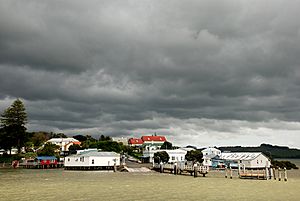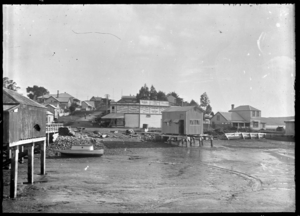Rawene facts for kids
Quick facts for kids
Rawene
|
|
|---|---|

Rawene, as viewed from the water
|
|
| Country | New Zealand |
| Region | Northland Region |
| District | Far North District |
| Ward | Kaikohe/Hokianga |
| Community | Kaikohe-Hokianga |
| Subdivision | South Hokianga |
| Electorates |
|
| Area | |
| • Total | 2.15 km2 (0.83 sq mi) |
| Population
(June 2023)
|
|
| • Total | 540 |
| • Density | 251.2/km2 (651/sq mi) |
Rawene is a small town located on the southern side of the Hokianga harbour in Northland, New Zealand. It sits at the tip of a land area that sticks out into the water, called a peninsula. State Highway 12 runs just south of the town. A special car ferry connects Rawene to Kohukohu and the northern part of Hokianga.
Contents
Rawene's Early History
Rawene began as an important place for the timber industry. In the early 1800s, a sawmill and shipyards were built here. This was because of the huge kauri trees found in the area.
In 1822, Captain James Herd took the first shipment of kauri wood from Hokianga on his ship, the Providence. He returned in 1825 as an agent for the first New Zealand Company. He sailed with two ships, the Rosanna and the Lambton, carrying 60 settlers.
Captain Herd tried to buy a very large piece of land. This deal was argued about, but for many years, Europeans called the town "Herd's Point". Later, it was known as "Hokianga Township". In 1884, it officially became "Rawene". This name might have been chosen to clearly identify its post office and telegraph services.
The town's post office started operating by 1845. It was one of only eight post offices in all of New Zealand at that time.
Important People and Places
Aperahama Taonui, a chief of the Te Popoto hapū (a Māori sub-tribe), is believed to have run a school in Rawene in the mid-1800s.
James Reddy Clendon, who used to be the United States Consul (a government official) in New Zealand, moved to Rawene in 1862. He worked as the local magistrate, which is like a judge, until 1867. His old house is still standing today and you can visit it.
By 1872, Rawene was growing. It had two hotels and two stores. There was a Wesleyan church, and the Roman Catholic church also owned land. The town's postmaster, customs officer, and magistrate was a person named Von Sturmer.
The Dog Tax War
During a conflict called the Dog Tax War in 1898, the people living in Rawene had to leave. They either went to Kohukohu or found safety on a steamer ship. This happened after a group of people who were protesting a dog tax threatened to march on the town.
On May 5, 1898, 120 men marched from Rawene towards Waima to deal with the "rebels." However, the disagreement was solved peacefully before they arrived.
Rawene's Health System
A small hospital was built on a hill overlooking Rawene in 1910. A newer, bigger hospital was finished in 1928. Dr George McCall Smith was in charge of the hospital from 1914 to 1948. He created a special health system for the Hokianga area that was quite unique.
In the early 1930s, Dr Smith became known for using a method called "painless childbirth." This involved giving mothers a special medicine called Nembutal along with Hyoscine before they gave birth. This method became very popular and attracted women to Rawene from all over the country. The hospital, which usually had about 30 births a year, suddenly had up to 200 births annually!
In 1937, a group called the "Commission of Inquiry into Maternity Services" looked into Dr Smith's practices. Dr Smith showed them records for his last 200 patients, and his results were excellent. No other hospital could show better results.
In the 1940s, the government made Hokianga a special health area. This meant that all doctors in Hokianga were paid a salary. Also, all doctor visits, medicines, tests, and hospital stays were free for everyone. The whole system was paid for by a grant based on the number of people living there.
Rawene's Population Today
Statistics New Zealand describes Rawene as a rural settlement. It covers about 2.15 square kilometers. As of 2018, it had an estimated population of 495 people.
| Historical population for Rawene | ||
|---|---|---|
| Year | Pop. | ±% p.a. |
| 2006 | 441 | — |
| 2013 | 471 | +0.94% |
| 2018 | 495 | +1.00% |
| 2023 | 474 | −0.86% |
In the 2023 New Zealand census, Rawene had 474 residents. This was a small decrease of 21 people since the 2018 census. There were an equal number of males and females, 237 each, living in 207 homes.
The average age in Rawene was 55.4 years old. About 15.2% of the people were under 15 years old, and 35.4% were 65 or older.
People in Rawene come from different backgrounds:
- 55.7% identified as European (Pākehā).
- 61.4% identified as Māori.
- Smaller numbers identified as Pasifika, Asian, or other groups.
Most people (96.2%) spoke English. About 24.7% also spoke the Māori language.
When it came to religion, 39.2% identified as Christian. A large group, 46.2%, said they had no religion.
For those aged 15 and older, about 13.4% had a university degree or higher. Many people (50%) had a certificate or diploma after high school. The average income was $25,100, which is lower than the national average. About 24.6% of people aged 15 and over worked full-time.
Learning in Rawene
Rawene School is a primary school for students from years 1 to 8. It teaches both boys and girls. As of 2024, it has about 100 students.
In 1922, a room was added to Rawene Primary School for older students who were studying at a secondary level. Later, in 1947, a separate Rawene District High School was built. It was made bigger in 1952, but sadly, it was destroyed by a fire in 1972.
The Rawene Learning Centre is also located here. It is a campus of NorthTec, which is a polytechnic (a type of college that teaches practical skills).
Famous People from Rawene
- Norm Maxwell: A well-known rugby union player who was an All Black.
- Ron Guthrey: He was the mayor of Christchurch from 1968 to 1971.
- Gordon Cochrane: A pilot who flew bomber planes for the Royal New Zealand Air Force during World War II.
- René Shadbolt: A nurse who worked in the Spanish Civil War and later became the head nurse (matron) at Hokianga hospital.
- George McCall Smith: A doctor, hospital superintendent, and an important community leader in Rawene.



